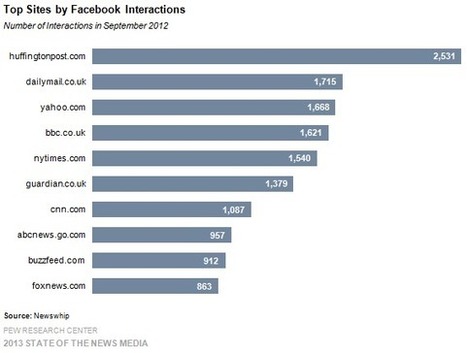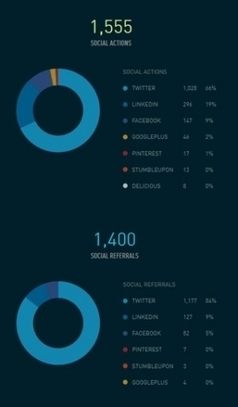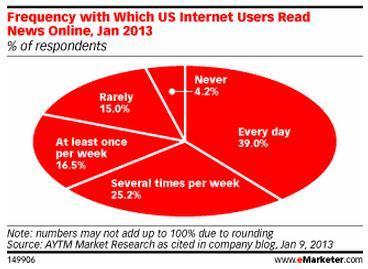 Your new post is loading...
 Your new post is loading...
When Facebook introduced its redesigned News Feed, it did more than change how people view memes and photos of cats — it altered the way stories are seen. Now everyone can make news. But for those who make a living by spreading news, Facebook has changed the way stories are presented. Dean Praetorius, a senior editor with The Huffington Post, talked with AllFacebook about how the way news is presented on Facebook requires some changes to the traditional approach. The Huffington Post has recently been lauded for its popularity on Facebook. Pew Research Center presented findings regarding news and social media, citing a study by Newswhip showing that the online newspaper was by far the most engaged news source on Facebook. In terms of Facebook interactions, HuffPost beat out more traditional companies, such as The Daily Mail, The New York Times, and CNN. How did HuffPost accomplish this? Praetorius said that the company has taken a well-rounded approach to social media, knowing that the story is far from completed when it’s published. HuffPost also thinks about stories differently from print media outlets and TV stations. Praetorius said that stories on the site are meant to generate conversation, and not so much to simply inform, as an old-school newspaper would...
The 44 entries in the “Digital Innovation” category we were judging were some help. But not as much we had hoped. The top of the list, thankfully, exemplified the award criteria of finding “fresh, engaging” ways to do great journalism. What does that look like? Think Snow Fall from The New York Times, which ended up winning the award. Big data projects from ProPublica, narrated graphics from the Los Angeles Times, the killer iPad app by Reuters, Bloomberg’s infographics, and News 21’s interactive video trailer presentation also had the judges uttering words like “stunning,” “mind-blowing,” “amazing” and “powerful.” What set them apart from the rest of the entries was the way that each one found a creative — and effective — way to use a digital technique or tool to tell a story or convey information. Here’s a quick look at this judge’s favorites...
...The media loves to attach labels to trends. When one catches on, the rush begins. Native advertising (the buzzword of choice right now), social advertising, content marketing and sponsor curation all revolve around the notion of brands as publishers. Everyone’s jockeying for position, FORBES included. Marketers want a bigger voice. The media business needs revenue. The digital world demands change. So, what’s required for this new form of marketing — and for journalism to continue to flourish? Ah, here’s where the fun begins. Buzzfeed talks about viral content. The Huffington Post is into “aligning content and paid advertising strategies.”The Atlantic uses “Sponsor Content Presented By (pick the advertiser). Gawker’s done something similar (it’s actually now talking about a commerce play). As for us, I often talk about brand journalism. BrandVoice is based on the philosophical belief that marketers, with deep understanding of their industries, can offer smart insights, too. In most traditional media companies, that’s a tough sell. Journalists can barely swallow the advertorial — it must be placed in the print or digital equivalent of Siberia. The fact is is, with the click of a mouse or the touch of a screen, the audience can check a marketer’s veracity as easily as it can a journalist’s....
Newsweek's top editors faced a different kind of danger than the Flying Wallendas. Katharine Graham, publisher of The Washington Post and owner of Newsweek, made a habit of decapitating her editors. ...Very few “star” journalists of that time and space have made the trip to the digital world. Most of those I spoke with and saw are pretty much doing what they did 20 and 30 years ago. They’re doing it for traditional media companies that haven’t changed much either, although executives at each have convinced themselves otherwise. Those no longer working romanticized about the past. The experience also reminded me of something I repeatedly told Tim Forbes three or four years ago when I was deep into my startup, True/Slant. “There’s a new wave of of talent out there that’s going to blow past traditional journalists — and they don’t even see it coming.”
We’re fortunate to have members of that new wave at FORBES. They do their jobs differently, particularly when freed from hierarchical editing systems to build their own brands and be accountable for their own success. They relate to and engage with the audience unlike a past generation of reporters who could care less what readers thought (after all, what do they know?). Using the tools of social media, they follow their colleagues as competitive beat reporters to gain insight from them. Most important, they banter with them in full public view, a far more raw, if not real, version of any “news analysis” than shows up in newsprint. Sometimes, they even ride the crest of a competitor’s scoop by filtering it through their own eyes for different audiences. They produce their own videos, photos and galleries and podcasts to extend their reach. And they trust in Google, angling stories (and a story’s headline) to give them the best chance of reaching the world. In the video below, six people who sit in our newsroom talk about their jobs and the FORBES model of digital journalism.
More than half of Americans watch news clips and broadcasts online—and 37% say they watch less cable TV news than they previously did. Cord-cutting and increased mobile usage play significant roles in news consumption via the internet.
INTERESTING TREND? YouTube is considering launching a service dedicated to investigative journalism in response to the decline of in-depth reporting at traditional news outlets. It is in discussions with a non-profit group based in California that funds investigative reporting and on-sells its reports to news outlets around America. The Centre for Investigative Reporting (CIR) in Berkeley, California, has had a meeting with the video-sharing website to discuss the possibility of collaboration. YouTube wants CIR, which is funded by private donations, to curate material for what it plans to call YouTube Investigative....
|
The grizzled vet and the digital native: Journalism has plenty of room for both to succeed. I spent eight years at AOL and I'll say this: I saw none of the great, all of the bad and some of the good. ... The blood sport during my AOL days was about the future of media companies — who would or wouldn’t survive the digital onslaught. Actually, it was much the same during my time at Newsweek in the 80s (who needed three newsweeklies in a broadcast world). Ditto when I joined The New York Times in the 70s (was the city big enough for both The Post and Daily News). Now, the social Web with its echo chamber turns up the volume daily — and makes it more personal, too. It’s far more about the fate of the individual journalist. That quickly gets down to the paycheck. Will there be one? How much? Who gets it — the “professional” or the pretender? Consumer demand for credible news and information is greater than ever. The problem is the 100-year-old model for producing it is forever broken. That’s why more attention must be paid to finding new ways to produce quality journalism — efficiently, at scale and at a price supported by mobile CPMs, which at best are 50% lower than desktop CPMs, which if you’re lucky come in two-thirds lower than print CPMs. In other words, a high-cost newsroom structure built for the print age will never work in a smartphone or tablet world. A few startups are experimenting with new models — Vox Media, Machinima, Bleacher Report and Storify are a few that I follow. Among traditional media companies, FORBES is the only one I know of charting a new course....
Polis, the journalism think-tank at the LSE, has published an in-depth report looking at the value of social media to journalism, specifically public service broadcasting, and it highlights how Twitter has come to dominate news. As the report puts it, Twitter plays a more important role in newsgathering than Facebook, which is much more about discussion and far less about breaking news. Lyse Doucet, the BBC’s Chief International Correspondent puts it this way: “There is no question, if you are not on Facebook and Twitter, you are not getting the full story”. More telling is the comment from Joanna Carr, editor of BBC Radio 4′s news programme ‘PM’, who said she “wouldn’t hire anybody who doesn’t know how to use Twitter”....
There is an entire universe opening up for publishers who can build cross-media content ecosystems that connect with consumers by informing, exciting and inspiring them.... To get an idea of how focusing on subscription revenue leads nowhere, let’s take a look at recent financial reports (3rd quarter 2012) from The New York Times and The Washington Post companies. The NY Times instituted a paywall, while WaPo did not. So how did it turn out? The NY Times digital ad revenue declined by 2%(which was offset by a rise in subscriptions) while WaPo’s digital ad revenues increased by 13%. In other words, while the WaPO is building a business that will double in six years, the NY Times is merely treading water. It’s pretty easy to see where things will go from here. As the NY times saturates it’s consumer base, growth in subscription revenues will slow and eventually reverse. They will be left with fewer readers (Mathew Ingram estimates that they have lost 15% of their audience since they instituted the paywall), a worsening financial position and a diminished brand....
Social media management has grown from a curiosity to anintegral piece of effective social media strategy in the space of just a few years. Nearly overnight, companies have brought on whole teams of specialists to craft effective social media strategies and manage multiplying numbers of social media accounts. Companies will be hungry for better social media management tools in 2013, too....
Until now, hundreds of independent NPR and PBS affiliates have had no common resource for best practices in social media. ...The Corporation for Public Broadcasting wants to fill that gap with a newly released social media handbook for stations, which is hosted at the National Center for Media Engagement website. CPB commissioned the marketing firm iStrategy Labs to write a guide that targets a broad audience: not just the stations who need guidance, but the stations who still need convincing of social media’s value....
|



 Your new post is loading...
Your new post is loading...















Very interesting perspective on "news" by HuffPo editor Dean Praetorious.